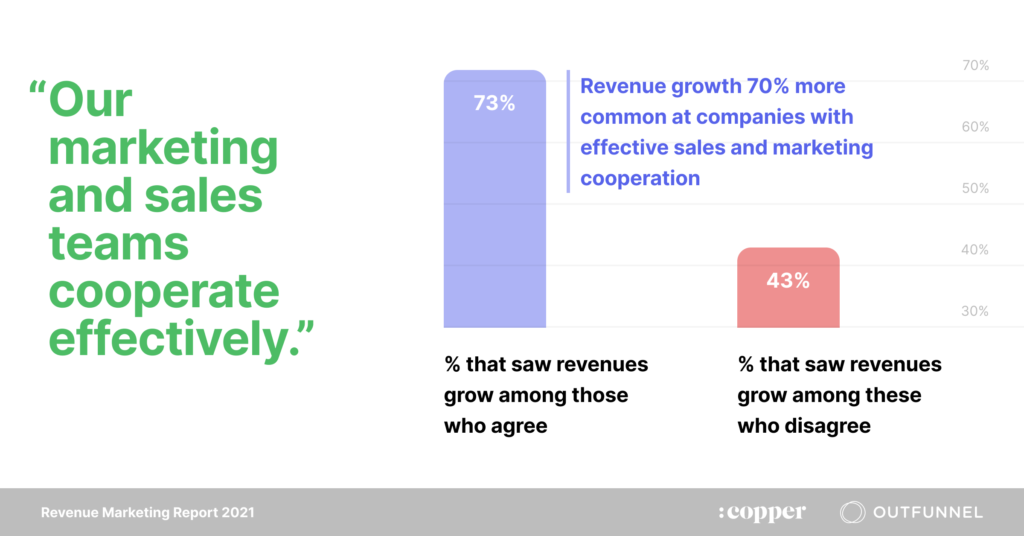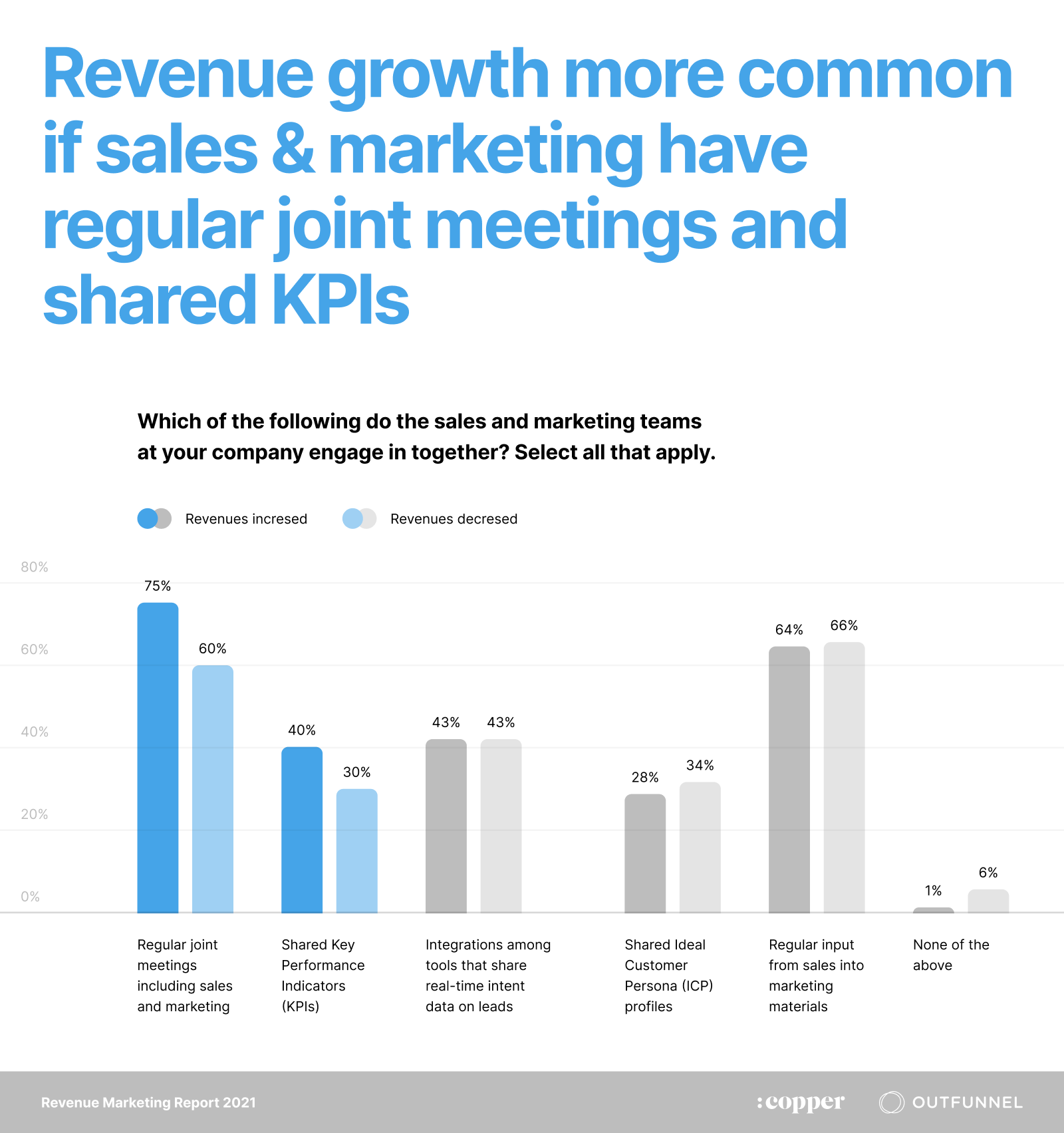Last updated: March 8, 2022
Sales and marketing integration is obviously a good thing.
According to a recent study, revenue growth is 70% more common in B2B organizations with tightly aligned sales and marketing.

Source: Revenue Marketing Report 2021
Which makes sense! When the lead generation and revenue engines are running smoothly, you get more qualified traffic to your website, more high-quality leads into your sales funnel, and more new customers. Everyone is happy.
In practice, however, many companies end up having sales and marketing teams that operate in silos, are misaligned, and even outright frustrated with each other.
Have you noticed that whenever your sales results are not meeting your expectations, your marketing and sales teams always have something to say about the other?
The most typical scenario is this:
- Marketing accuses sales of throwing away their leads with poor sales tactics or lack of follow-through.
- Sales accuses marketing of providing low-quality leads in the first place, setting them up for failure.
The fundamental conflict between sales and marketing isn’t surprising. After all, these teams are responsible for the opposing ends of the customers’ buying journey. Handled correctly though, this can be a creative tension that fuels sales productivity, effective revenue marketing , and an all-around better experience for your customers.
Unfortunately, often the tension ends up being unproductive, creating a lose-lose situation that leads to needless stress and frustration.
What can you do about it?
1. Beware misaligned incentives—make plans, set goals, and track KPIs together
Whenever you investigate why sales and marketing aren’t getting along, at the heart of it you’ll find misaligned incentives.
So if you want your marketing and your sales force aligned, their goals and targets have to be aligned, too. If marketing is being incentivized to optimize for sheer volume of leads produced regardless of quality, then sales is invariably going to be frustrated with low-quality leads.
What can we learn from people who have dealt with this scenario? In an interesting podcast about sales and marketing integration, Intercom’s Jeff Serlin and Brian Kotlyar talk about how focusing on revenue goals rather than sales or marketing goals is an effective way to navigate the chaos.
“There has to be a revenue plan, not a sales plan and a marketing plan. […] I think it has to start with a shared premise of what the objective is.”
– Jeff Serlin, Intercom sales operations
Have sales and marketing collaborate across teams to create mutually developed plans, goals, terminology, and KPIs.
In fact, research shows a clear correlation between shared KPIs and revenue growth.
According to the Revenue Marketing Report 2021, 36.5% of B2B sales and marketing leaders report they have shared KPIs between the teams. And this number increased to 40% in companies with increased revenues, and fell to 30% in companies where revenues decreased. Similarly, there’s a correlation with regular joint meetings.
Implementing such tactics is not difficult. Here at Outfunnel, we have a monthly meeting where both sales and marketing report on their results. We track KPIs together—such as traffic, signups, and conversions, as well as the numbers of new leads, new customers and churned customers. Everything that impacts the bottom line.
Setting key performance indicators that sales and marketing share is a good place to start.
Here are a few questions that your marketing and sales team could explore together to help better align their goals:
- What is the mutual goal for this week/month/quarter, and what are the department-specific KPIs to aim for?
- Can the company as a whole agree about how to define or score quality leads? This will help reduce conflict and misunderstanding over low-quality leads.
- Are there any specific “perverse incentive” situations that are causing the teams to work against each others’ interests? Can they be dismantled, or at least acknowledged and discussed openly?
2. Open the lines of communication—you want each team to better appreciate how the other help achieve company goals
For people to work well together, they have to understand each other. Grow and Convert’s Benji Hiyam pointed out that “oftentimes, the biggest challenge between sales and marketing working synergistically, is a lack of understanding of each other’s role.”
Once general plans are in place for integrated sales and marketing, each team must be held mutually accountable for bringing in results. Communication, both within and across departments, is key.
In addition to regular meetings, you can make use of project management tools to automate reminders, assign tasks, and maintain up-to-date information across departments. Popular project management platforms include Trello, Basecamp, Asana, and others.
Keeping communication open, transparent, and trackable will help your teams work together without excessive duplication or frustration.
“Where it goes wrong is when there’s a misalignment of expectations of what the supply chain is trying to make, misalignment of the plan that we should have co-developed to get there, and lastly sometimes I think there’s just a lack of understanding that both jobs are hard.”
– Brian Kotlyar, Intercom marketing
At Outfunnel, our sales and customer support puts together a monthly report about why trial users are not buying our subscription, and why some customers churn. This information is highly valuable also for marketing, development, and management.
Also, we have one dedicated Slack channel for sales, marketing, and customer support. There we share valuable insights we have learned about our customers but also invite colleagues to read a useful article, a book or listen to a podcast.
Here are some questions your teams could discuss together to get better aligned in understanding each other:
- What marketing collateral should be developed to assist sales during one-on-one conversations?
- What information can sales share to help marketing attract better, more qualified leads?
- What is the feedback from sales regarding the quality of the leads? If it’s not great, how to improve it?
- What specific information should be exchanged so that each team can do its job better?
3. Involve sales and customer support in marketing—their intimate knowledge of customer struggles will strengthen your messaging
Sales and customer support know where the gaps in marketing are.
What are the things that new customers get confused by, or misunderstand? These are things that your sales and support teams are currently dealing with over and over again.
These challenges could potentially be resolved by having marketing better educate potential customers in terms of what to expect. Not only does this create a better customer experience, but it’s also a great way for your marketing team to build goodwill with their colleagues in sales and support!
“Data and content working together is today’s marketing currency. The better we leverage both in concert with the buying cycle, the more quickly we close any gaps and support the sales team’s journey.”
– Steve Kozek, Citizen’s Bank
Here are a few ways in which these traditionally end-of-funnel teams can help marketers improve their content and increase their ROI:
- Ask the sales department to suggest topics for content marketing or printed marketing collateral
- Listen to recorded sales calls or meetings to find more descriptive, sticky language
- Rely on sales reps’ experience and knowledge to craft more accurate buyers personas
- Add leads back into marketing funnel for further nurturing if sales team sends them back for not being warm enough.
4. Be more deliberate about thinking in terms of sales and marketing operations—make the operations explicit and visible to all
When a business is first starting out, it might be a solo founder doing all the work. After a while, it might grow into a small, tight-knit team with sales and marketing people who informally have a good idea of what each other is thinking. But this doesn’t scale, and the rate of errors and miscommunications increases the more you leave it up to chance.
It’s all connected. While you’re thinking about KPIs, incentives and communications for individuals, it’s also a good practice to frame your sales and marketing tasks as operations, or functions. This means breaking down the processes into a clear picture that everyone involved can look at, and contribute to.
“As the companies gets bigger and more complicated, the role of operations is to preserve that the one-ness, the single-team way of working.”
– Brian Kotlyar, marketing at Intercom
When the teams are small, it’s ultimately management’s job to make sure that the operations are in good shape. It’s about asking, “what are the specific things that sales and marketing need to have taken care of in order to do their jobs better?”
It’s healthy to have every member of the team think about this to some degree, and as the team grows, it can be smart to make sure that it’s someone’s responsibility to keep these operations running smoothly. These days, it’s often a Chief Revenue Officer or a Revenue Operations Manager.
When it comes to sales and marketing operations, you want to be thinking about:
- Metrics and data – how are you measuring your success?
- Integrations and automations – how are the tools you’re using working together?
- Processes – how is everything being done? (This can get quite recursive!)
5. Keep your business data in a single centralized location to minimize wasted time and effort
If your teams are spending time every day hunting down and retrieving data, wrangling with tools and settings, exporting CSV files and uploading them… your teams are wasting time.
Working with data that is kept in a single centralized location allows your marketing and sales team to get real-time, actionable intelligence about your leads. This typically means a business contact management system like a CRM.
For example, a CRM with well-integrated marketing data will give you visibility into how your leads are engaging with your digital marketing efforts, e.g. emails, blog articles or ads.
Tools like Outfunnel help with sales and marketing integration, as they collate data from marketing source into the CRM, or vice versa.
As a result:
- Sales will have more data-rich information about leads before they officially enter their part of the funnel (allowing sales reps to tailor their approach, provide more useful content, know which leads to call first and ultimately close more deals).
- Marketing will be able to follow their leads throughout the entire customer journey (allowing them to tweak and change their marketing strategy, as well as tactics, from paid advertising, email campaigns, content marketing, to website targeting/personalization).
If you are using multiple marketing tools, see if they can be integrated with the CRM where you keep your data. It’s important because the more info you can bring together into one CRM, the more your team will benefit from it.
Full visibility across departments is essential for sales and marketing integration to work. It is the core of bringing the teams together.
Just make sure your data is always in sync. With several tools integrated into one CRM information can get lost. So, choose a marketing automation tool that keeps your data in sync with sales processes 24/7.
Conclusion: sales and marketing integration at the tactical level requires alignment at the strategic level
If you really dig deep into why things aren’t well-integrated, you’ll often find that it’s fundamentally because of the way the teams are structured. This in turn is shaped by the company’s culture and priorities.
If you give both teams unrealistic targets that they cannot possibly meet, for example, then it’s only natural for them to blame each other when they fall short. So, at the heart of all of this is “how does your company think about sales and marketing?”. Is one function being treated as more important than the other? Is one team understaffed and overworked?
Be honest with yourself and your team about the challenges you are facing, listen to their concerns, and do your best to get everybody on the same page. If you do that right, your own salespeople and marketers may even independently start seeking out ways to interface better with each other!





